When it comes to landscaping, hostas are a go-to choice for adding lush greenery and texture to your garden. With their wide variety of shapes, sizes, and colors, they can fit seamlessly into any style—from cozy cottage gardens to sleek modern landscapes. In this guide, we showcase 23 ways to use hostas in your landscaping projects, giving you plenty of inspiration to incorporate these lovely plants into your outdoor spaces.
Creating a Hosta Border

Creating a hosta border can bring life to your garden. Hostas are known for their lush, green leaves and can create a beautiful contrast with other plants.
In the image, you can see a winding path bordered by hostas and other greenery. The rich greens of the hostas frame the walkway, drawing the eye along the path. This design not only enhances visual interest but also provides a welcoming vibe.
When planning your hosta border, consider the variety of hostas available. Some have variegated leaves that can brighten up the space, while others have deep green foliage that adds depth.
Don’t forget to mix in some colorful plants and flowers along the way. This balance will create a more dynamic look and allow the hostas to shine even more.
Hostas for Shady Areas
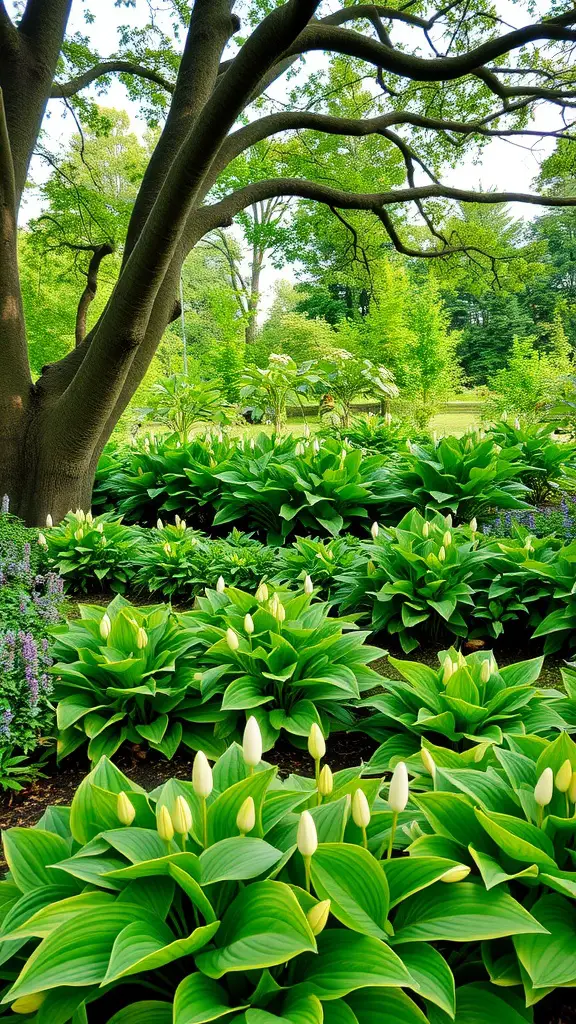
Hostas are a favorite among gardeners, especially when it comes to shady spots. Their lush, green leaves create a vibrant carpet under trees and shrubs. In the image, you can see a lovely arrangement of hostas thriving in a shaded area, surrounded by a variety of greenery.
The thick leaves of hostas come in many shades and shapes, adding texture to your landscape. They are perfect for those tricky spots where sunlight is limited. As you can see, the hostas in the photo are just starting to bloom, showcasing their lovely white flower buds. These blooms will eventually add a graceful touch to your garden.
When planting hostas, consider their placement carefully. They enjoy rich, moist soil, but they can adapt to different conditions. The combination of the tall tree overhead and the hostas below creates a serene, inviting atmosphere. Mixing hostas with other shade-loving plants can also enhance the visual interest in your garden.
So, if you’re looking to transform those shaded areas of your yard, hostas are a great choice. They bring life and color, making your garden feel lush and full. Plus, they require minimal maintenance, allowing you to enjoy your garden without too much fuss.
Managing Hostas in Dry Conditions

Hostas are beloved for their lush foliage and adaptability, but they can struggle in dry conditions. This image shows a variety of hostas planted in a garden, alongside some helpful tips for managing them effectively.
When watering hostas, it’s essential to ensure they receive enough moisture. A good rule of thumb is to water deeply but infrequently. This encourages the plants to develop strong roots that can reach moisture further down in the soil.
Mulching around the base of the hostas can help conserve soil moisture. Organic mulch not only retains water but also adds nutrients as it breaks down. Just be sure to keep it a few inches away from the plant stems to prevent rot.
Additionally, consider planting hostas in areas that receive morning sun and afternoon shade. This helps protect them from the heat of the day, reducing water loss through evaporation.
Finally, monitor your hostas for signs of stress, such as wilting or browning leaves. If this happens, provide extra care and adjustments to your watering schedule. With these tips, you can keep your hostas thriving, even in dry conditions.
Mixing Hostas with Other Perennials
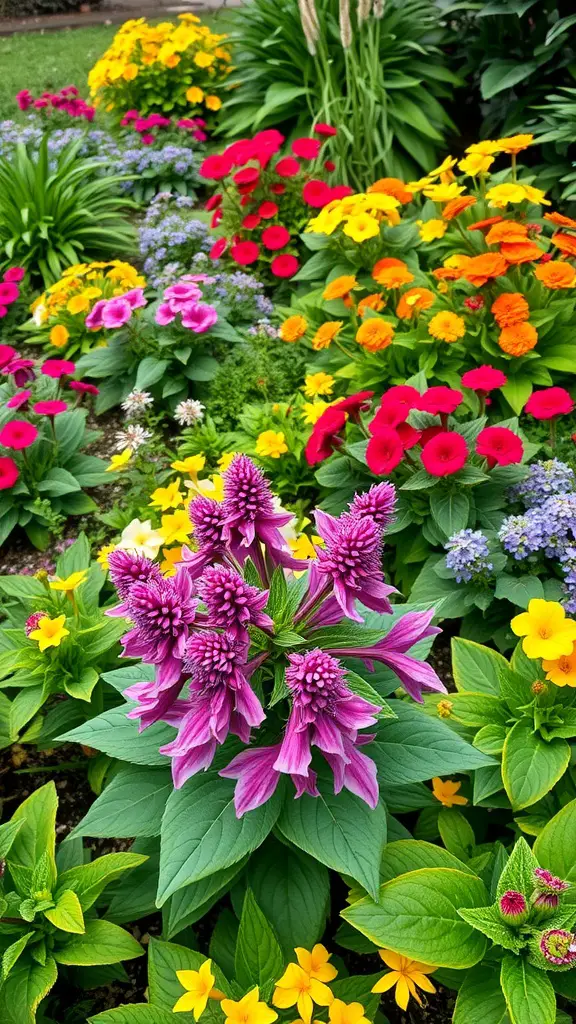
When it comes to landscaping, mixing hostas with other perennials can create a vibrant and dynamic garden space. In the image above, you can see a delightful arrangement of colorful flowers surrounding lush green hostas. The variety of colors and shapes enhances the overall appeal, making the garden feel alive.
Hostas are known for their beautiful foliage and come in various sizes and shades of green. In this garden, they serve as a lovely backdrop to the bright flowers in shades of pink, yellow, and red. By layering different heights and textures, you can build a rich tapestry of colors that brings depth to your garden.
Consider planting hostas alongside low-growing flowers like creeping phlox or daylilies. This type of combination not only showcases the hostas’ leaves but also allows the flowers to shine. Adding a few taller blooms, such as delphiniums or hollyhocks, can create an eye-catching vertical element.
Incorporating perennials that bloom at different times of the year ensures that your garden looks great all season long. For example, spring-blooming flowers can provide early color while hostas fill in during summer. This thoughtful approach keeps your garden interesting and full of life.
Don’t forget about foliage! Mixing in perennials with unique leaf patterns or colors alongside hostas can create a striking visual contrast. The combination of textures can elevate the overall design, making each element stand out even more.
Watering Techniques for Healthy Hostas

Hostas are lovely plants that thrive in a variety of garden settings. To ensure they remain lush and vibrant, proper watering techniques are essential. In the image, we see a gardener using a watering can to gently hydrate the hostas surrounded by colorful blooms.
When watering hostas, it’s important to soak the soil thoroughly, as they enjoy moisture. Early morning is often the best time to water, allowing the leaves to dry before evening. This helps prevent diseases that thrive in damp conditions.
Using a watering can, as seen in the image, allows for more control. It’s easy to direct the water right at the base of the plants. Avoid overhead watering as this can lead to excess moisture on the leaves, which some varieties are susceptible to.
Another great technique is to create a watering schedule. Check the soil moisture regularly by sticking your finger into the ground. If it feels dry an inch down, it’s time to water. Consistency is key to keeping your hostas healthy.
Lastly, mulching around hostas can help retain moisture in the soil. This not only keeps the roots hydrated but also reduces weed growth, which might compete for nutrients. Incorporating these watering tips will surely help your hostas flourish!
Choosing the Right Hostas for Your Garden
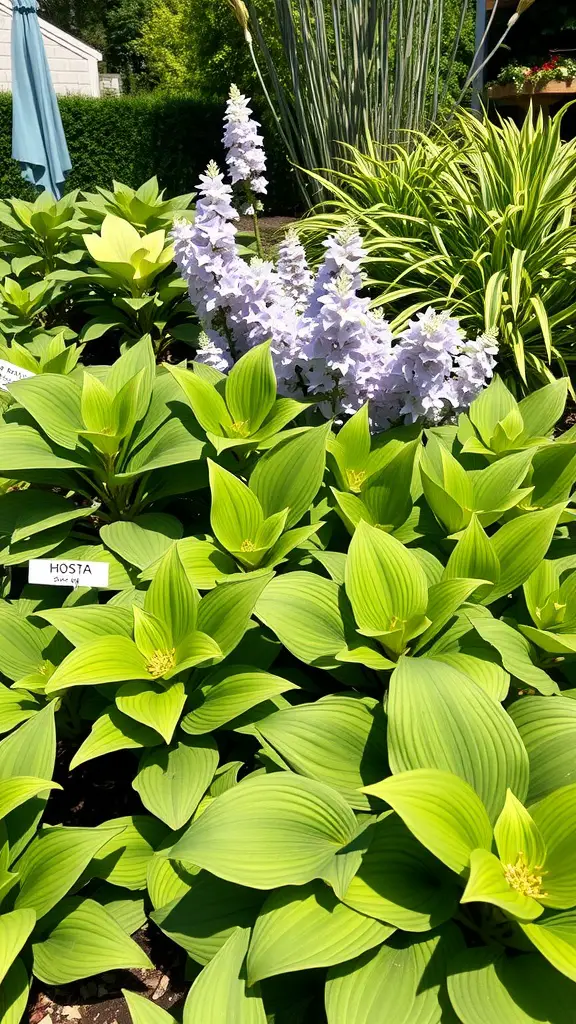
Hostas are a delightful addition to any garden, offering lush foliage and varied textures. In the image, you see a vibrant display of hostas, showcasing their broad, leafy greens that create a rich backdrop for other plants. The sunlight enhances their colors, making them look even more inviting.
When selecting hostas for your garden, consider their size and growth habit. Some varieties are compact, while others can grow quite large. The hostas in the picture appear to have a lovely, uniform leaf pattern, which adds to the overall aesthetic. Pairing them with complimentary flowers, like the light purple blooms also shown, can create a stunning visual contrast.
Another important factor is the light conditions in your garden. Hostas thrive in shady spots. This image hints at a serene, shaded area that would be ideal for these plants. Make sure to assess your garden’s light and choose varieties that will flourish in it.
Lastly, think about the color variations available. The hostas here display vibrant greens, but you can find varieties with blue or variegated leaves. Mixing in different colors can add depth and interest to your landscape. Overall, hostas can transform your garden into a lush, inviting retreat with the right selection.
The Ideal Soil Conditions for Hostas
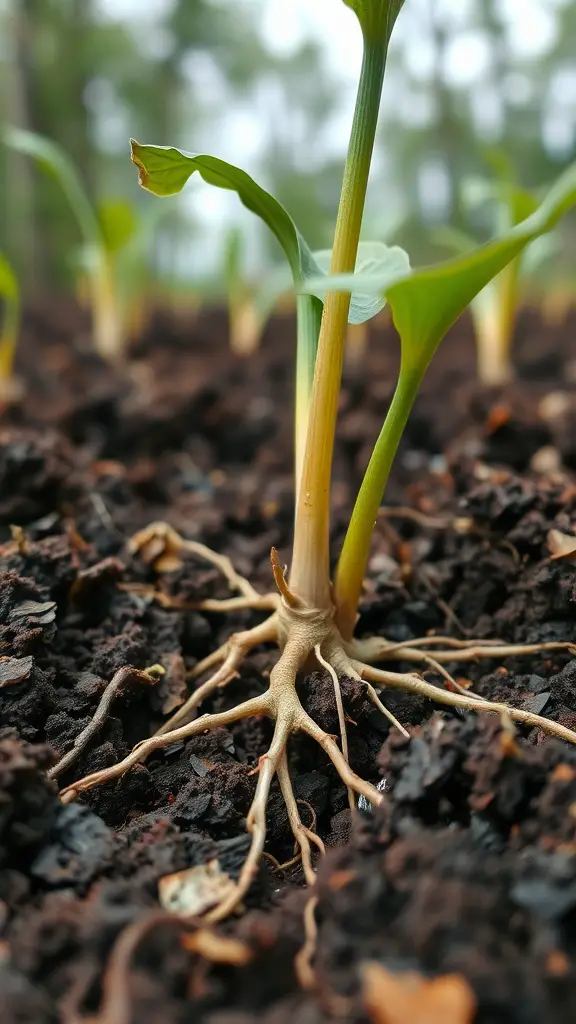
When it comes to growing hostas, the right soil conditions are crucial. Looking at the image, you can see a young hosta plant with its roots firmly established in rich, dark soil. This kind of soil supports healthy growth, enabling the plant to soak up nutrients and water effectively.
Hostas thrive in moist, well-drained soil. The texture of the soil in the photo suggests it is loose enough to allow for good drainage but retains moisture, which is essential for these shade-loving plants. A balanced mix of organic matter ensures that the hostas receive the nutrients they need.
Adding compost or well-rotted manure can enhance the soil quality. This not only improves fertility but also helps with moisture retention. You want your hostas to have a comfortable, nutrient-rich environment where they can grow strong and vibrant.
It’s also worth noting that hostas prefer a slightly acidic to neutral pH, typically between 6.0 to 7.5. Checking your soil’s pH can help in creating the ideal conditions for these lovely plants. In summary, focus on rich, loamy soil that can retain moisture, and your hostas will surely flourish!
Companion Plants for Hostas

When it comes to landscaping with hostas, choosing the right companion plants can really elevate your garden’s look. In the image, we see a vibrant mix of greenery and color that perfectly complements the lush foliage of hostas. The bright green fronds of the ferns stand out and provide a textured backdrop, creating a lovely contrast.
In addition to ferns, you might want to consider plants like astilbe or heuchera. Astilbe offers beautiful feathery flowers that add softness to the garden. Heuchera, on the other hand, comes in various colors and helps to fill in any gaps in your planting scheme. Both of these plants thrive in similar conditions as hostas, making them perfect partners.
Another interesting option is to include flowering plants like blue lungwort or foxglove. Their blooms can bring pops of color that draw the eye. The blue flowers seen in the background of our image provide a nice touch of color against the lush green leaves.
By layering these plants with hostas, you can create a visually appealing garden that offers texture, color, and interest throughout the growing season. Remember that the key is to create a balance between foliage and flowers, allowing each plant to shine while supporting the others.
The Beauty of Variegated Hostas
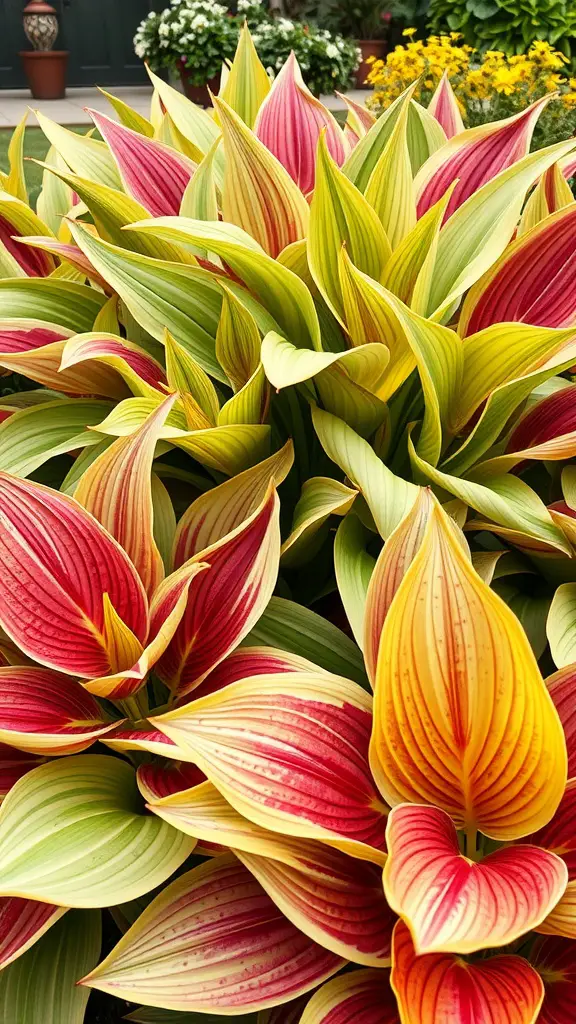
Variegated hostas are a true delight in any garden. The vibrant colors and unique patterns of their leaves can brighten up any outdoor space. The mix of greens, yellows, and reds adds a lively touch, making these plants stand out.
In the image, you can see a stunning display of variegated hostas. The leaves range from deep green to bright yellow, with rich red stripes that create a beautiful contrast. This combination not only draws the eye but also brings warmth and energy to the landscape.
These plants are quite versatile and can be used in various settings. Whether you place them in borders, containers, or as focal points in your garden, they can enhance the overall design. Plus, they pair well with other flowers and foliage, creating a harmonious look.
Another advantage of variegated hostas is their low maintenance needs. Once established, they thrive in partial to full shade and require minimal care. This makes them a favorite for both seasoned gardeners and newcomers alike.
Dealing with Hostas Pests and Diseases
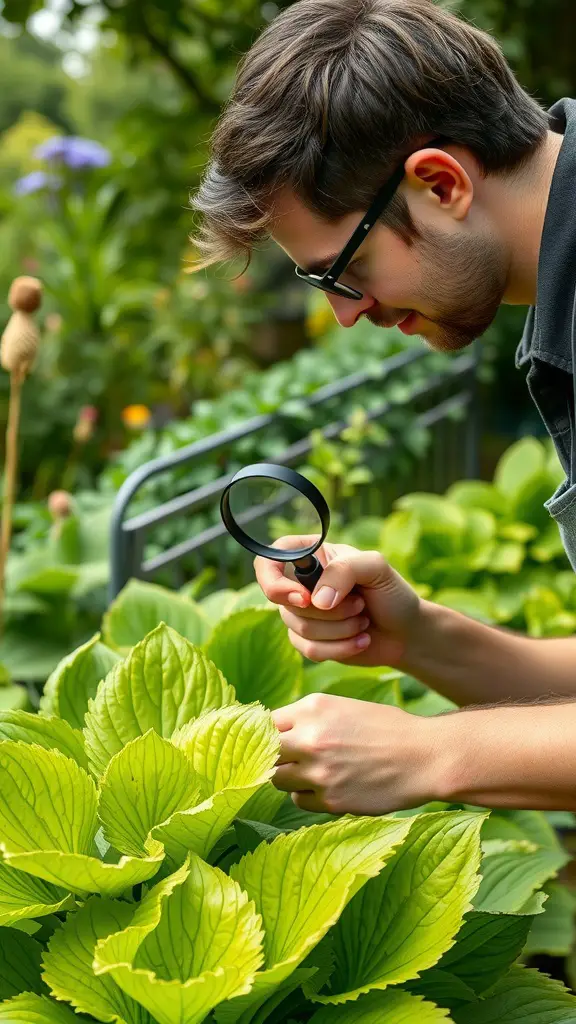
Hostas are beautiful and popular plants, but they can face their share of pests and diseases. In the image, we see someone closely inspecting a lush hosta plant with a magnifying glass. This careful examination is a great practice for any hosta enthusiast.
Regular checks can help you spot problems early. Look for signs of pests, like slugs or snails, which love to munch on those tender leaves. If you see holes or discoloration, it’s time to investigate further.
Another common issue is fungal diseases, which can thrive in damp conditions. Make sure your hostas have good air circulation and avoid overhead watering. If you notice any irregular spots, removing affected leaves can help prevent the spread.
Using organic pest control methods can keep your plants safe while managing issues. Neem oil is a popular choice for both pests and diseases. Just be sure to apply it during cooler parts of the day to avoid leaf burn.
Hostas as Ground Cover
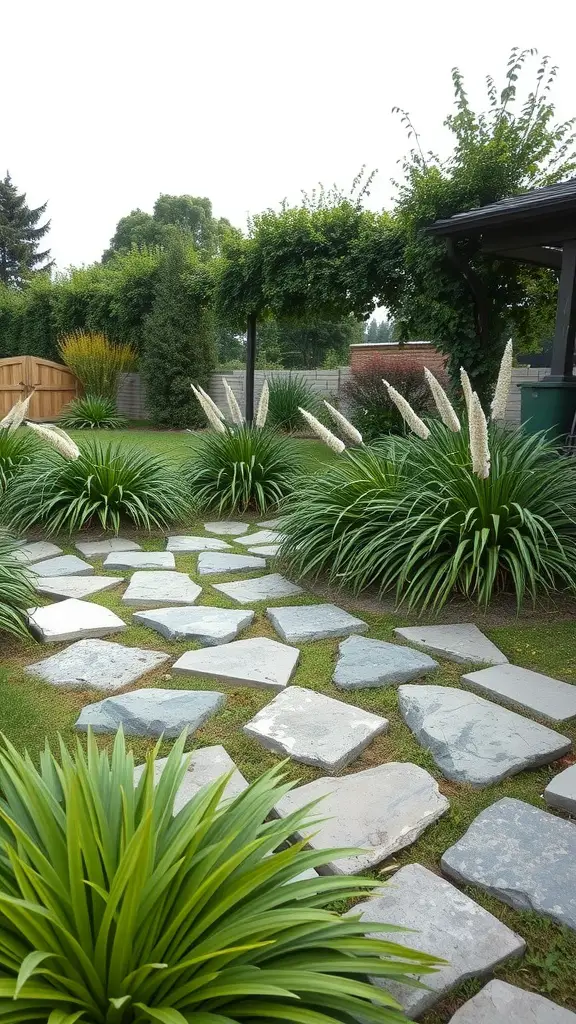
Hostas are a fantastic choice for ground cover, especially in shaded areas where other plants might struggle. Their lush foliage creates a beautiful carpet that can fill in empty spaces beautifully. In the image, you can see how hostas thrive around stone pathways, adding a pop of green to the landscape.
The various shades of green, from vibrant to deeper tones, make hostas versatile. They can complement many designs and styles. Plus, their large leaves provide a nice texture contrast against the hard surfaces of the stones.
Another perk of using hostas as ground cover is their low maintenance. Once established, they require little care, making them perfect for busy gardeners. Just a little watering during dry spells and occasional trimming can keep them looking tidy.
In the image, the hostas not only beautify the yard but also offer a practical solution to reduce soil erosion around the path. Their root systems hold soil in place, creating a stable environment. So, whether you’re looking to fill in gaps or create a lush garden vibe, hostas can be a wonderful addition.
Hosta Maintenance Through the Seasons

Hostas are a favorite among gardeners for their lush foliage and versatility. In the image, you can see a vibrant display of hostas in various colors and textures, showcasing how they can bring life to any landscape. The different growth stages marked through the seasons give a clear view of what to expect as the year unfolds.
In spring, hostas awaken from their winter slumber. This is when you should start checking for any dead leaves that need trimming. New growth begins to emerge, making it the perfect time for planting or dividing existing hostas to encourage fuller plants.
As summer arrives, hostas are in their glory. They thrive in the warmth, and regular watering helps keep their leaves fresh and vibrant. During this time, you might notice blooming flowers atop tall stalks, adding even more beauty to your garden.
When fall rolls around, it’s time to prepare hostas for the colder months. You can prune back any spent foliage and clean up fallen leaves to prevent pests and diseases. Mulching around the plants will help protect their roots as temperatures drop.
Finally, winter is a time of rest for hostas. They will go dormant, but it’s important to ensure they are adequately mulched to shield them from harsh conditions. With proper care through each season, your hostas will provide a stunning display year after year.
Using Hostas for Container Gardening
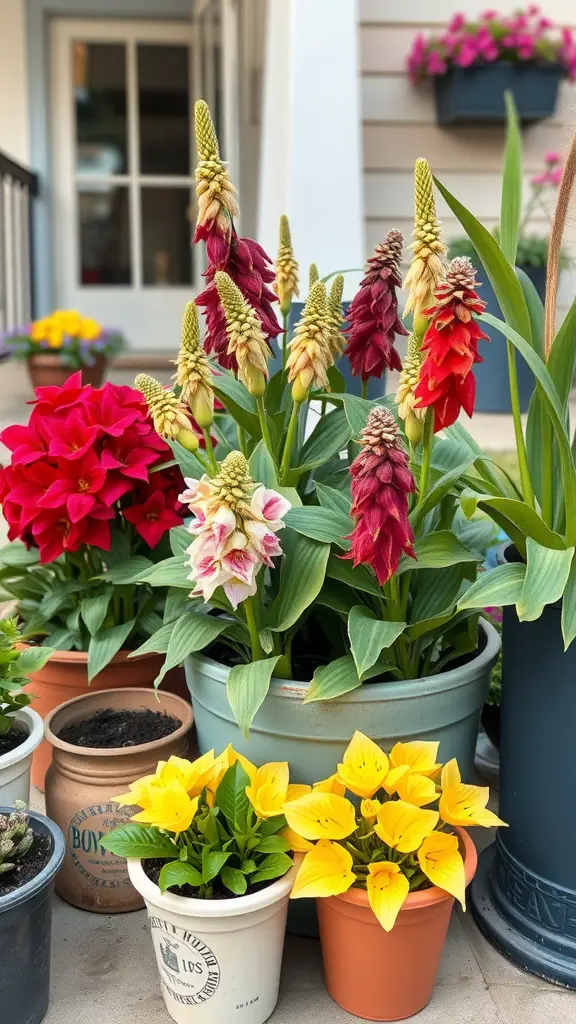
Hostas are lovely plants that can really brighten up your container garden. In the image, you can see a mix of colorful flowers, but the hostas stand out with their vibrant green leaves. These plants are known for their versatility and ability to thrive in various settings.
Container gardening with hostas is a fun way to add greenery to patios, balconies, or even entryways. They come in different sizes and colors, making it easy to choose the right variety for your space. The bright yellow hostas in the foreground add a cheerful touch, complementing the other flowers beautifully.
One of the best things about hostas is that they require minimal care once established. Just make sure they get enough shade and water, and you’ll see them flourish. Whether you’re looking to create a serene outdoor space or a lively display, hostas fit right in.
Hostas for Small Spaces
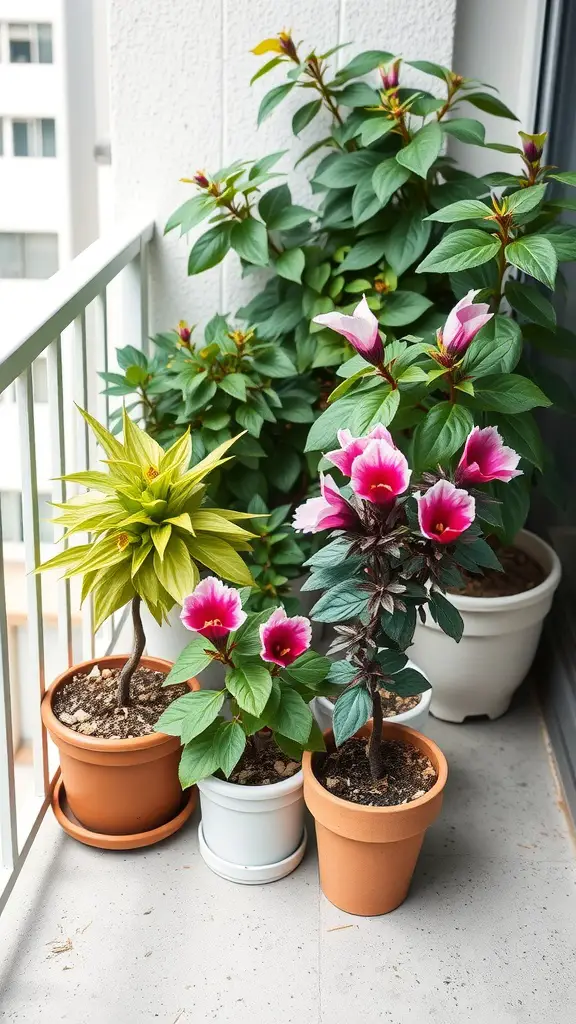
When you’re working with limited space, hostas can be a top choice for your garden or balcony. These plants thrive in various environments and are versatile enough to fit into tight spots. In the image, you can see a collection of vibrant potted plants, showcasing how well hostas can coexist with other flowers.
The arrangement on a small balcony illustrates that you don’t need a sprawling garden to enjoy the beauty of hostas. Their lush green foliage pairs nicely with colorful blooms, creating a visually appealing display. The pots are different sizes, allowing for an interesting mix that adds depth to the space.
One of the perks of using hostas in small areas is their ability to grow in shade. They can brighten up corners that receive little sunlight, making them perfect for urban settings. By choosing various types and colors, you can create a vibrant atmosphere without overwhelming the area.
Incorporating hostas into your small landscaping project can be fulfilling. They not only enhance your space but also offer a calming effect with their greenery. So, if you’re looking to bring some life to your little balcony or garden, consider adding these lovely plants!
Incorporating Hostas in Rock Gardens
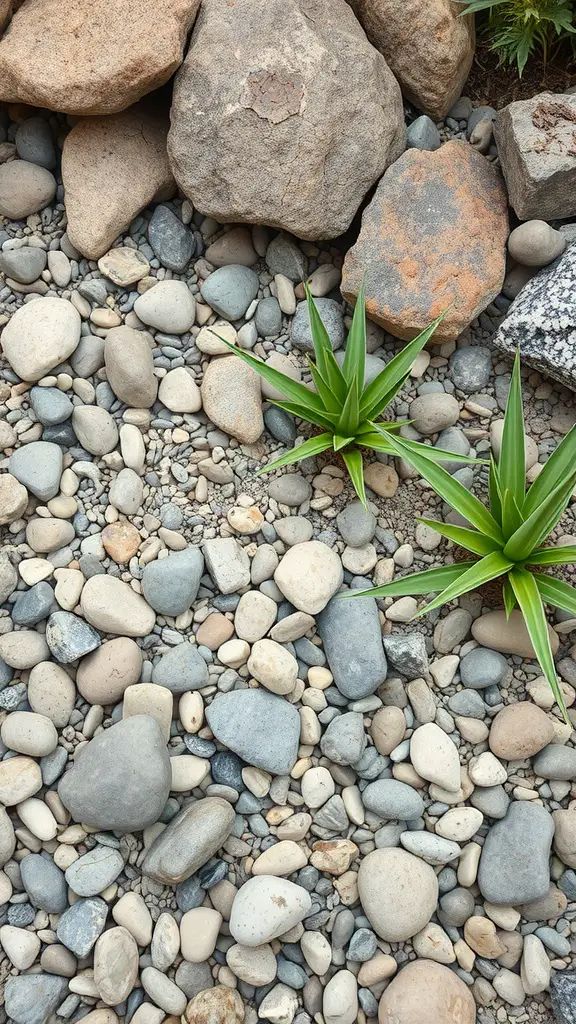
Hostas are a lovely addition to rock gardens, bringing a splash of greenery and texture to your landscape. The image shows a beautiful arrangement of rocks and pebbles, creating an ideal setting for these plants to thrive. The contrasting shapes and colors of the stones highlight the graceful leaves of the hostas.
When designing your rock garden, consider placing hostas among the stones. Their lush foliage can soften the rough edges of the rocks and create a serene atmosphere. You can choose different varieties of hostas to add an interesting mix of sizes and leaf colors, which will complement the natural stone.
Make sure to position the hostas in areas where they can receive some shade, as they thrive in cooler conditions. The rocks can help retain moisture in the soil, which is beneficial for the hostas. Adding mulch or smaller stones around the base of the plants can also help with moisture retention.
Incorporating hostas into your rock garden not only enhances the visual appeal but also supports a healthy ecosystem. They attract various pollinators, which can benefit other plants in your garden. So, get creative with your rock arrangements and let those hostas shine!
Creating Texture with Hostas

Hostas are a fantastic choice for adding texture to any landscape. Their broad, lush leaves come in a variety of shapes and colors, creating visual interest from every angle. In the image, you can see a vibrant mix of green and reddish leaves. This combination not only enhances the beauty of the garden but also adds layers of texture that catch the eye.
The way the leaves overlap and interweave creates a natural softness in the landscape. It’s important to consider the different types of hostas available, as they can range from small, compact varieties to large, dramatic ones. Mixing different sizes can make your garden feel more dynamic.
Incorporating hostas into your garden design is all about balance. Pair them with other plants that have contrasting textures, such as spiky grasses or delicate flowers. This approach creates a layered look that is pleasing to the eye. Don’t be afraid to experiment with placement; sometimes, the most unexpected arrangements yield the best results.
Another tip is to pay attention to the light conditions in your garden. Hostas thrive in partial to full shade, making them an excellent choice for those tricky spots where other plants struggle. With their adaptability and variety, hostas can truly transform your garden into a textured paradise.
Hostas in Garden Design Themes
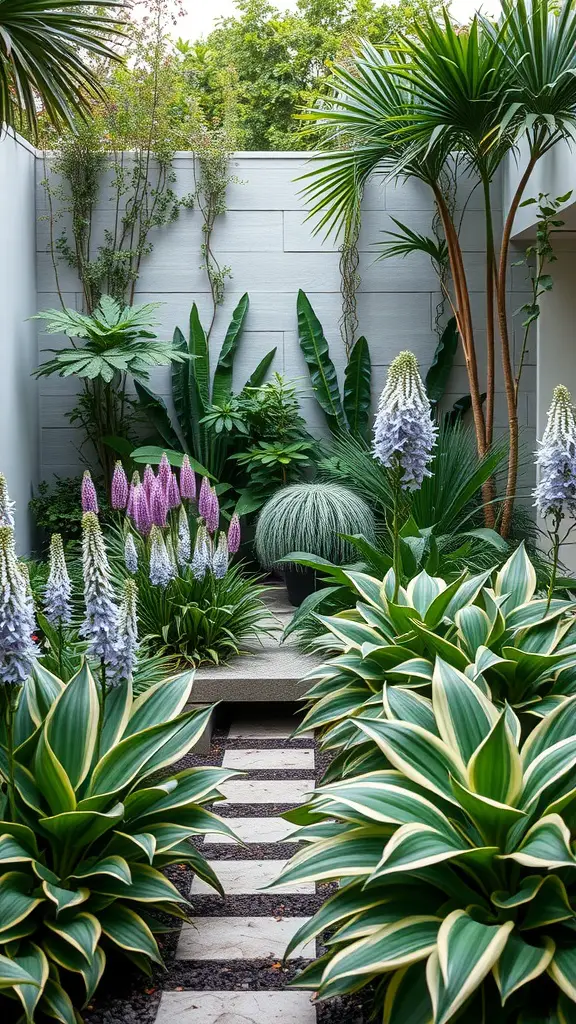
Incorporating hostas into your garden design can create a lush and welcoming atmosphere. This image showcases a beautifully arranged garden where hostas play a key role in the overall theme. Their vibrant green and cream-striped leaves create a striking contrast against other plants, making them a focal point.
The path made of large stones invites visitors to explore the garden further. This design effectively uses hostas to frame the pathway, leading the eye along the route. The combination of various plants, including tall flowers and tropical foliage, enhances the overall aesthetic, showcasing how hostas can harmonize with different garden elements.
Not only do hostas add visual interest, but they also thrive in shaded areas, making them an excellent choice for gardens that may not get a lot of sun. This characteristic allows gardeners to utilize spaces that might otherwise be challenging to plant. By mixing hostas with other plants, you can create depth and texture in your garden design, turning a simple space into a vibrant retreat.
The Role of Hostas in Wildlife Gardens
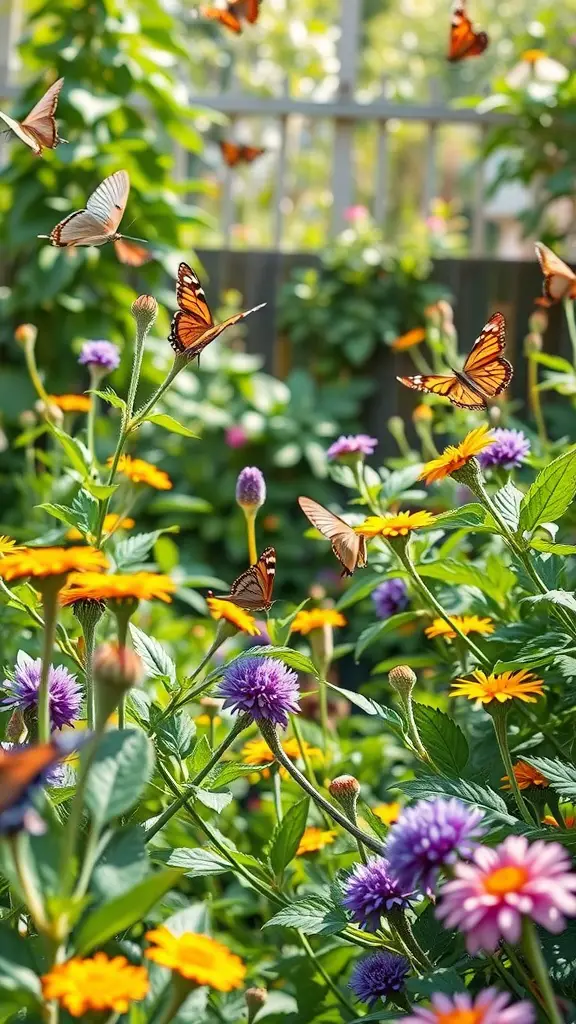
Hostas are not just lovely to look at; they play a vital role in wildlife gardens. These plants offer shelter and food for various creatures, especially pollinators. The lush foliage of hostas creates a cozy environment for insects and small animals, making them a great addition to any wildlife-friendly landscape.
In a garden buzzing with life, like the one in the image, hostas can provide contrast to the vibrant colors of blooming flowers. As you observe the butterflies fluttering around, you can see how essential hostas are in attracting these pollinators. The combination of hostas and flowering plants creates a rich habitat that supports a diverse ecosystem.
When planted alongside other flora, hostas can help enhance the overall health of your garden. They not only attract beneficial insects but also contribute to the beauty of the landscape. The broad leaves can also serve as a natural mulch, keeping the soil moist and aiding in the growth of surrounding plants.
Designing a Hosta-Centric Garden

Hostas are a favorite for many gardeners, known for their lush foliage and variety of shapes and colors. In the image above, you can see a beautifully arranged garden layout that highlights the charm of hostas. The vibrant greens and yellows create a lively atmosphere, making the garden an inviting space.
The pathway guides your eye through the garden, creating a sense of flow. This design helps to showcase hostas as the main feature while allowing other plants to complement them. Mixing different varieties of hostas can bring out fascinating contrasts in leaf shapes and colors.
Incorporating other plants, like the purple and red foliage seen here, adds depth and visual interest. Each plant has its role, and together they create a harmonious scene. When planning your hosta-centric garden, consider how different plants interact and support each other.
Finally, keep in mind the growing conditions of your plants. Hostas thrive in partial shade, so placing them strategically can enhance their beauty. With thoughtful design, your garden can become a peaceful retreat full of life and color.
Propagation Techniques for Hostas

In the image, we see a gardener tending to a vibrant hosta garden. The lush green leaves of the hostas stand out beautifully against the backdrop of a well-maintained landscape. This scene embodies the joy of gardening and the care needed to nurture these plants.
Hostas are popular for their lovely foliage and are relatively easy to propagate. One common method is division. This involves digging up the hosta plant and carefully separating the root clumps. It’s best to do this in early spring or fall when the plants are not actively growing.
Another method is through offsets, which are smaller plants that develop around the main hosta. These can be detached and replanted. When propagating, choose healthy parent plants and make sure to provide them with the right soil and sunlight to flourish.
Remember, hostas thrive in shaded areas, making them perfect for spots where other plants might struggle. With the right care, you can easily expand your garden with these lovely perennials.
Hostas for Edging Pathways
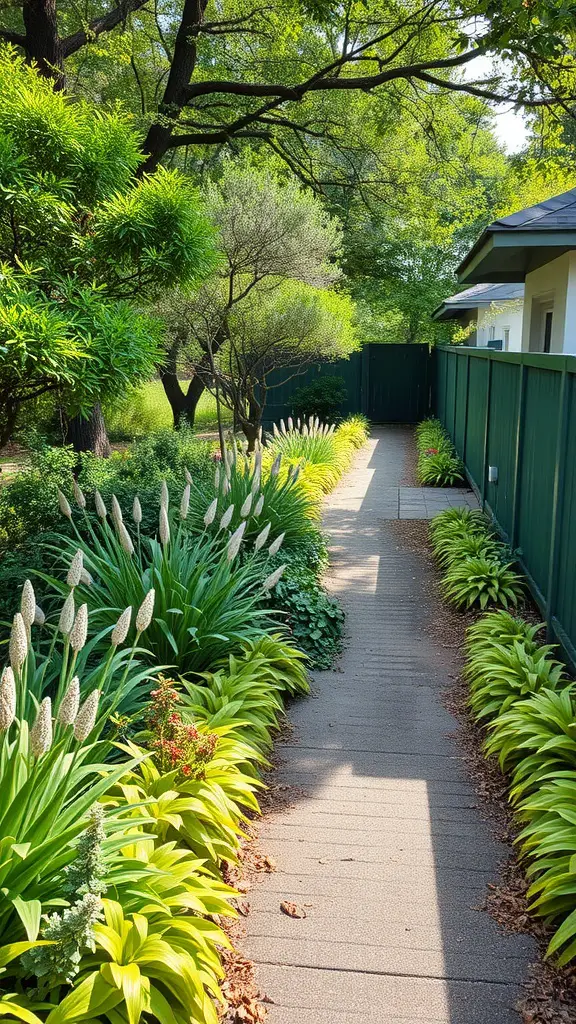
Using hostas to edge pathways is a lovely choice for any garden. The image shows a serene walkway lined with vibrant hostas, creating a soft and inviting atmosphere. Their lush green leaves contrast beautifully with the surrounding elements, making the path more appealing.
Hostas come in various sizes and colors, which allows for creative landscaping. You can choose lighter shades for a fresh look or deeper greens for a more dramatic effect. The tall flower spikes emerging from the hostas add an extra layer of interest as they bloom.
These plants thrive in shade, making them perfect for areas where sunlight is limited. They also require minimal maintenance, so they are great for gardeners looking for a low-effort option. With their dense foliage, hostas help define the space, guiding visitors along the path while showcasing the beauty of nature.
Think about mixing different varieties for added texture and color. Pairing hostas with other shade-loving plants can create a dynamic and lush border that enhances the overall landscape. Whether you have a small garden or a larger outdoor area, hostas can truly elevate your pathway design.
Seasonal Hostas Blooms

Hostas are a lovely addition to any garden, especially when they bloom during the warmer months. These plants showcase beautiful flowers that can enhance the overall landscape. Each season brings its own unique charm, making hostas a versatile choice for gardeners.
The image captures the delicate beauty of hosta flowers in a vibrant garden setting. The tall, elegant spikes display clusters of pink and white blooms, surrounded by lush green foliage. These flowers attract pollinators like bees, adding life to your garden. As you wander through a hosta garden, you can appreciate the varied colors and forms.
Many varieties of hostas bloom at different times, so you can enjoy their flowers from late spring through summer. This seasonal display not only adds visual interest but also creates a habitat for beneficial insects. Adjusting your garden layout to highlight these blooms can make your outdoor space more inviting.
Showcasing Hostas in Landscape Architecture

Hostas are a fantastic choice for landscape design, offering lush greenery and varied textures. In the image, you can see hostas lining a pathway alongside modern architecture. Their vibrant foliage creates a soft contrast against the sleek glass and concrete.
These plants thrive in shade or partial sunlight, making them perfect for areas that may not get as much direct light. The way they are arranged in the landscape adds a touch of nature, bringing a calming feel to the surroundings.
Alongside the hostas, you also notice trees that provide additional shade and height. This combination not only enhances the visual appeal but also promotes biodiversity. Hostas can house beneficial insects and provide shelter for small critters.
Incorporating hostas into your landscaping can be very rewarding. They require minimal maintenance, making them suitable for busy landscapes. Whether used as borders or in groups, hostas can transform a simple walkway into a green oasis.




